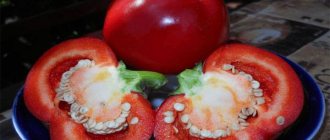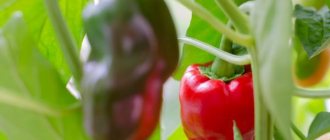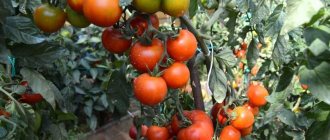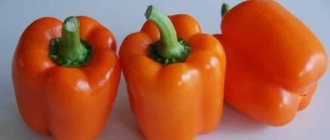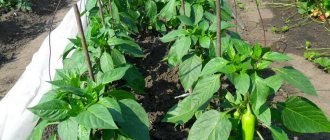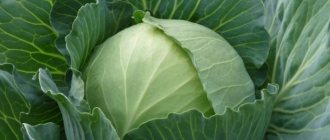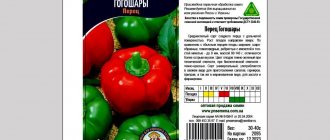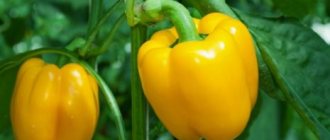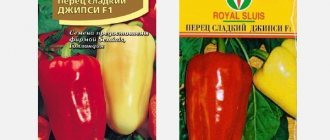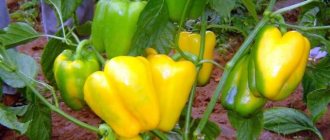Features of the variety
Every vegetable grower wants to recoup the time and effort spent and get a bountiful pepper harvest . In this matter, the choice of variety, taking into account the climatic characteristics of the area, plays an important role. The Winnie the Pooh variety is excellent for growing in any region of Russia.
Winnie the Pooh pepper was bred by Moldovan breeders in 1980 for cultivation in the central part of Russia. This is a hybrid of the Lastochka and Bouqueten 3 varieties.
Characteristics and description
The bush is compact, standard, low . It grows up to 25-30 cm, the branches are pressed tightly to the stem. The fruits on the plant are arranged in bunches, which contributes to a bountiful harvest. The amount of foliage on the branches is minimal.
Important! It is better to plant sweet peppers away from bitter varieties, as cross-pollination between plants can occur, and as a result, the taste of all the fruits will deteriorate.
Distinctive features
Juicy and sweet fruits can be consumed both fresh and after heat treatment . Vegetable growers highly value the taste of Winnie the Pooh and the fleshiness of its fruits with a pulp thickness of 5 mm. The vegetable lends itself well to transportation and is stored for a long time.
On a note. For a bountiful harvest, pepper bushes are planted as densely as possible. Since the branches of the crop are tightly pressed to the trunk, per 1 sq. m can fit up to 20-25 plants.
Fruit characteristics and yield
The fruits are mixed on the bushes, have the shape of a sharp cone, and reach 10 cm in length . At different stages of ripening, the color of the fruit changes. Ready-to-eat vegetables have a red tint; during technical ripeness, peppers are mostly waxy or green.
The average fruit weight is 50 g . They ripen in large batches, which is very convenient, since the entire harvest is harvested in about 3 times. Productivity – 5 kg per 1 sq. m. The plant is resistant to diseases characteristic of pepper.
The ripening period of the crop is from 105 to 112 days from the appearance of full-fledged sprouts . In the conditions of the middle zone, pepper seeds are planted as seedlings in February-March, and in June you can already taste the vegetables.
Features of care
Seedlings are moved to a permanent place of growth at the age of 60-70 days. When planting, please note that Winnie the Pooh loves light, fertile soils with a pH of 6-6.5.
The recommended arrangement of bushes is 50 by 35 cm. The variety is suitable for thickened planting, per 1 sq. m you can place from 8 to 12 bushes.
The cultivar is interesting for growing due to its low maintenance requirements. It has no stepsons, it does not need shaping: pinching the top and removing side shoots. However, some gardeners stubbornly remove the top shoot of this variety, as a result they lose half the harvest.
Caring for peppers comes down to traditional measures: regular moistening, removing weeds and providing aeration to allow air to reach the roots.
Peppers need to be watered at intervals of 3 days, loosen the soil after each watering and weed. To avoid the last two procedures, when growing in greenhouses, many gardeners practice mulching the soil with hay or straw.
Preparation for cultivation
Before sowing, the seeds are soaked in a solution of potassium permanganate . For this you will need 1 tsp. Mix the drug in 200 g of clean water. After processing, the seeds are laid out in one layer on a damp cloth and covered with it. They are left in this position until full germination. As a rule, this takes 1-2 days.
At this time, vegetable growers can start preparing the soil mixture . It is important that the substrate is not too dense and allows moisture to pass through well. Before using the soil, it is better to treat it with a solution of potassium permanganate.
For which regions is the variety suitable?
The breeders who created this variety recommend planting it in areas of the country that belong to the first, third and fourth light zones. Such regions include Kalmykia, Khakassia, Tatarstan, Karelia, Yakutia, the Komi Republic, Altai and many others.
In addition, the Winnie the Pooh variety can be grown in any climate. It is suitable for growing in the Moscow region, central Russia, the Urals, Siberia, and the Far East. The most important thing to pay attention to is the light zone in which the region is located.
Seeds should be sown immediately in pots
Growing seedlings
It is possible to sow seeds with or without picking ; we will talk about the pros and cons of both methods.
With a pick
This option is good because the transplant is carried out as a whole lump of earth . In this case, the roots of the plant are not injured. Picking is done when two true leaves appear. The optimal temperature during the day is +22…+25°С, at night up to +15…+18°С. The seed is planted in rows in flat containers; there should be a distance of at least 5 cm between the seeds.
The top of the container is covered with film or glass and placed in a warm place . When the first shoots appear (after 7-10 days), the film is removed and the seedlings are transferred to a bright room. The seedlings are planted in separate containers, one sprout at a time, at the same level (without deepening the stem). As the seedlings grow, they are transplanted into larger containers.
Attention! The soil on the site should not be oversaturated with nitrogen, otherwise the plant will fatten, which will lead to a decrease in yield.
Without picking
In this case, the seeds are immediately sown in different containers; for this purpose it is better to use peat cups . They are planted two seeds at a time, then the weaker seedling is removed.
Important! The soil should not be allowed to dry out: it should always be moist.
To increase the protective capacity and rapid growth of seedlings, every 10 days they are treated with the biological stimulant "Epin-Extra". It is diluted in water according to the instructions.
Seedling care
The organization of favorable conditions for plants is as follows:
- seedlings are placed in a warm, draft-free room;
- required air temperature – +15…+22°C;
- for additional lighting, artificial lighting is used in the form of LED lamps or fluorescent lamps;
- periodic watering is carried out moderately (as the soil is added and always with warm, settled water);
- 2 weeks after the appearance of 2-3 leaves, the seedlings are fed: approximately 0.5 tsp of urea and 2.5 ml of potassium humate are used per 10 liters of water.
Hardening of seedlings
Before planting seedlings in a summer cottage, they need to be hardened off . The event begins 2 weeks before planting. Containers with seedlings are taken outside. At first, they are left in the fresh air for 4-5 minutes, gradually increasing this time.
Important! Using cold water from a tap or from a well for irrigation is unacceptable, as this can lead to root rot, fungal diseases and plant death.
Planting seedlings
To cultivate peppers in open ground, select a sunny place, sheltered from the wind.
The crop is placed in the bed where beans, peas or cabbage were previously grown . Such precursors create favorable conditions for pepper. The bed is pre-enriched with compost. Plants are planted densely, buried to the leaves and the soil is compacted.
To stimulate fruiting and rapid growth of the bushes, the pods are regularly collected and the shoots that are located below the fork of the central stem are trimmed. The ovary still does not form there.
Important! In order for the plant to get used to the new climate, it is advisable to protect the pepper seedlings with film for a couple of days after planting them in open ground.
Further care
Comprehensive care includes periodic watering, fertilizing and proper attention to the soil.
Peppers are watered 2-3 times a week using warm, settled water . In the summer season, plantings are watered systematically, but moderately - excess moisture harms the roots. For peppers, the ideal type of irrigation is drip irrigation.
Pepper does not tolerate dry soil surfaces well . In this case, it will drop its inflorescences and foliage. Therefore, after planting the plants, immediately mulch the beds with compost, peat or humus. In summer, dry lawn grass can be used as mulch. After each watering, shallow loosening of the soil is carried out and at the same time get rid of weeds.
It is recommended to add organic matter and universal mineral compounds to the soil as top dressing . Plantings are fertilized no more than once every two weeks. In early June, nitrogen fertilizing is used. In the future, they make a choice in favor of potassium and phosphorus nutrients. In the active blooming phase, fertilize with organic matter - add mullein diluted at a ratio of 1:10, or bird droppings diluted with water at a ratio of 1:15.
Important! Low-growing compact bushes of the Winnie the Pooh variety do not need a garter.
Dwarf pepper WINNIE THE POOH WITH HUGE FRUITS. Olga Chernova.
Important nuances of planting and growing
Winnie the Pooh does not make any special demands on the gardener when it comes to agricultural technology. But you will still have to devote a minimum of time and effort to planting if you do not want to be left completely without a harvest.
Most gardeners prefer to grow bell peppers using seedlings. Winnie the Pooh does not like picking, the roots of the plants are still too weak, so it is better to immediately plant the seeds in individual containers. This is done in the last ten days of February. Seedlings are transferred to closed ground at the end of April or early May, to an open bed - in early June. Its minimum age is 60–65 days, height is 20–25 cm, preferably the presence of 8–10 true leaves.
Do not rush to plant pepper seedlings in the garden; they should grow to the required dimensions.
Video: growing pepper seedlings
When planting in an open bed, be sure to wait until the threat of return frost has passed. To make it easier for plants to adapt to new conditions, cover the bed for a week with any covering material on the arches or cover the plants individually. This will protect the plantings from both low temperatures and sunburn.
Immediately after planting in the ground, it is advisable to protect pepper seedlings from adverse weather conditions.
Seeds need preliminary preparation. They are germinated for a week, wrapped in damp cloth or cotton wool, then soaked in a solution of any biostimulant. This way the shoots will appear faster. To enhance immunity, it is also recommended to treat with any fungicide of biological origin or in a pale pink solution of potassium permanganate.
To germinate pepper seeds, you can use purchased biostimulants (Epin, Kornevin, Heteroauxin) and folk remedies (honey solution, aloe juice, succinic acid)
The “small size” of the bushes makes it possible to cultivate Winnie the Pooh peppers when there is an acute shortage of space in the garden plot. Up to 25 plants are planted per 1 m². Even with such frequent placement, they will have enough space for food. It has been noticed that increased density of plantings has a positive effect on yields, slightly increasing the indicators.
No one forbids planting Winnie the Pooh peppers according to the standard 30*30 cm pattern for most varieties, but if you compact the plantings, you can significantly save space in the garden bed
Video: planting Winnie the Pooh peppers in the ground
It is not recommended to plant bitter peppers next to bell peppers. When cross-pollinated, Winnie the Pooh fruits can acquire uncharacteristic bitterness and pungency.
Bitter and bell peppers in the garden are placed as far apart as possible
Care during the active growing season includes keeping the bed clean, loosening it, regular watering and timely application of fertilizers. Timely weeding is especially important. Weeds can easily choke out small plants.
Obtaining a bountiful harvest of Winnie the Pooh peppers is impossible without competent agricultural technology
Winnie the Pooh is watered exclusively with heated water. The frequency is determined by the weather and growing conditions, but on average once every 3-5 days is enough. Approximately 0.7 liters are consumed per plant before fruit set, then the rate is increased by 1.5–2 times. After this, the substrate in the garden bed is loosened. Mulching will help retain moisture in the soil for a long time and prevent the appearance of weeds.
Darkened and slightly drooping leaves indicate that the Winnie the Pooh pepper needs watering.
Pepper Winnie the Pooh will gratefully respond to any feeding, organic or mineral. For the first time, fertilizers are applied 12–15 days after planting the seedlings in the ground, then at intervals of 2–2.5 weeks. It is advisable to alternate natural and store-bought fertilizers.
Store-bought fertilizers for peppers have a balanced composition, taking into account the need for certain macro- and microelements for the crop
Mineral fertilizers can be applied separately (nitrogen, phosphorus, potassium) or as part of special fertilizers for peppers and nightshades. A natural source of nitrogen is infusions of bird droppings, cow manure, nettle leaves, dandelion, potassium and phosphorus - a solution of wood ash. Plants need nitrogen only during the period of active growth of green mass. When applied at a later date, it weakens the immune system and provokes the bushes to actively form greenery to the detriment of fruit ripening.
An infusion for feeding peppers can be prepared not only from nettle or dandelion, but also from any other weeds; it is also useful to add a little stale rye bread to the container
Video: folk remedies for feeding bell peppers
Winnie the Pooh doesn't need any shaping. But it is necessary to regularly remove the stepsons growing below the first fork on the stem. They won't bear fruit anyway. Experience in growing this pepper shows that productivity can be increased if fruits that have reached technical ripeness are harvested. This stimulates the plant to form new ovaries.
Stepchildren take away nutrients from the bush that could ensure the ripening of more fruits
To prevent the development of diseases, annual treatment of the beds before planting seedlings and after harvesting is sufficient. The soil is shed with a thick crimson solution of potassium permanganate or treated with any biofungicide.
Potassium permanganate solution is one of the most common and affordable disinfectants, effective against pathogenic fungi
To protect the plantings from pests, any herbs and other plants with a characteristic odor are planted nearby. They can also be used as raw materials for preparing infusions and sprinkled on peppers during the summer.
Marigolds in the garden are not only beautiful, but also useful; their pungent odor is unpleasant to many harmful insects
Video: recommendations for growing sweet peppers
Features of growing the variety and possible difficulties
The land for cultivation should be prepared properly . As a planting soil for seedlings, use a composition that is sold in specialized stores or prepare it yourself.
The mixture is prepared from the following components:
- compost (2.5 kg);
- vermicompost (2.5 kg);
- peat (5 kg);
- ash (200-250 g).
If less or more soil is needed, these proportions are followed in preparation . The soil should be nutritious, loose and breathable. Fresh manure or partially decomposed compost cannot be used for seedlings.
Selection and description of the variety
Winnie the Pooh pepper is an invention of Moldovan breeders. A hybrid variety was created under the guidance of a plant breeder from Moldova, Yu. I. Panchev, and was officially registered in 1980. Experts managed to breed this species by crossing such sweet varieties as Buketen-3 and Lastochka. The pepper in question belongs to the group of early-ripening varieties. From the moment the first sprouts appear until the fruits reach technical ripeness, approximately 105–111 days pass.
Did you know? The hottest pepper known today is the Habanero pepper.
Cultivated by seedling method. It is successfully cultivated both in a greenhouse and in an open garden bed. Depending on the type of soil, climate and the implementation of planting care measures, the yield per 1 m² is 1.5–5 kg. The plant is short, compact, up to 25–30 cm long. The plant has a standard shape, the shoots are tightly attached to the trunk, the foliage is average. The pepper is shaped like a sharp cone. The length of one fruit does not exceed 10 cm, and the weight varies between 45–60 g.
Despite its size, the walls of the vegetable are quite fleshy - 5–8 mm. During the process of ripening, the fruit changes color: in the phase of technical maturity, peppers are light green, while fully ripened samples acquire an intense red tone. Winnie the Pooh tastes sweet. The variety is suitable for fresh consumption, it can be used in cooking, and its dense structure makes it possible to prepare high-quality preserves from it.
Diseases and pests characteristic of the variety
Whiteflies and aphids are the most common pepper pests . If unwanted “guests” are not identified in time, the harvest will deteriorate. For protection, use tobacco dust or wood ash. Also good remedies are liquid soap (200 ml of 72% laundry soap per bucket of water) or garlic infusion (200 g of crushed onion or garlic per 10 liters of liquid).
Of the chemicals, the most suitable are “Barrier”, “Barrier”, “Oxychom” and “Fundazol”.
Another common pest is spider mites . Plants are protected from it by using insecticides. To treat peppers against mites, use a solution of onion, garlic, dandelion or liquid soap.
Important! Plant wilting often occurs due to verticillium. As a rule, the causative agent of this disease lies in the soil. They fight the infection with Alirin or Glamir. One tablet of the product is dissolved in 2 liters of water and the beds are watered for preventive purposes.
The best varieties for greenhouses
Peppers are grown in greenhouses in regions with sudden weather changes and cool summers - in the Urals or Siberia. Greenhouses made of glass or polycarbonate and greenhouses are installed on the plots. The structures protect heat-loving peppers from rain, frost, fog and wind.
It is recommended to plant the following varieties:
- California miracle - ripens in 110-120 days. The cube-shaped, flattened fruits have an attractive appearance and a sweet aroma. The variety is unpretentious in care and universal in use. The Californian miracle is planted using seedlings.
- Hercules is an early ripening pepper, ripens in 90 days. The fruits are large, each weighing about 250 g. The walls are thick, the harvest can be transported over long distances. The taste is juicy and sweet.
- Agapovsky. The mid-early variety has prism-shaped fruits with sugary pulp. The color is bright red, the taste is pleasant. Pepper weight is about 130 g, per 1 sq. m harvest about 12 kg. Agapovsky ripens in 100-120 days.
- Atlant. A popular variety among beginning gardeners, it is easy to care for and does not require special skills. The weight of the fruit varies from 200 to 400 g, the flesh is crispy and sweet. There are many seeds, the wall thickness is 6 mm.
- Bogatyr - got its name because of the large fruits. Pepper weight 180 g, resistant to diseases and insects. Gardeners value the variety for its attractive commercial qualities and versatility in use.
Advantages and disadvantages of the variety
Positive aspects of the Winnie the Pooh variety:
- possibility of harvesting in several stages;
- early ripening;
- increased fruiting;
- transportability of fruits;
- long shelf life of vegetables;
- no need for a garter;
- good seed germination;
- unpretentiousness to climatic conditions;
- marketable condition;
- excellent taste;
- versatility in application;
- compactness of bushes;
- resistance to most diseases and pests
The variety has minimal disadvantages . In addition to the small size of the fruit, a flaw is considered to be the fact that when cultivating the vegetable in open ground, the growing season increases to 120-130 days.
Good to know:
Measures to combat fusarium wilt of pepper
Why peppers don’t bloom in a greenhouse: determining the cause of the problem
Fruit characteristics
- The fruits have the shape of a pointed cone and reach a length of about 10 cm.
- The average fruit weight is approximately 50 g, however, according to gardeners , it can grow up to 100 g.
- The color of the fruit changes depending on the stage of ripening. Ready-to-eat peppers turn red. At the stage of technical ripeness, vegetables have a green or waxy color.
- Peppers are juicy, sweet, suitable for consumption fresh and processed.
- Great taste.
- The flesh is fleshy, the wall is at least 5 mm thick.
- Resistant to long-term transportation.
- They have good keeping quality.
Reviews from gardeners
Many vegetable growers choose the Winnie the Pooh pepper variety because of its taste, ease of cultivation and abundant harvest . Reviews about it are mostly positive, because this crop is disease-resistant and easy to care for. Let's consider some opinions of those who grew this variety.
Svetlana, Voronezh : “My neighbors once advised me to grow Winnie the Pooh peppers. I planted the seeds without soaking, which is probably why not all of them sprouted. The seedlings were strong. I transplanted it into the greenhouse around mid-May. The harvest has grown as in the photo, the fruits are neat and even. They taste sweet. I recommend to all!".
Anna, Volgograd: “I grew Winnie the Pooh through seedlings, I left it a little too long: some of the bushes formed ovaries. Planted in the ground on May 25th. The plant has taken root perfectly. The fruits appeared in late July-early August. The bushes have grown about 30-35 cm. The peppers taste sweet and juicy. As for me, growing this crop is a labor-intensive process.”
Peter, Belgorod: “I have been planting the Winnie the Pooh variety for 7 years in a row. I plant it in the greenhouse in mid-April. Of all my varieties, it begins to bear fruit first. About eight fruits grow on one bush. I didn’t notice any particular difficulties in growing it. The only thing is the height of the bushes, which reach 40-45 cm. Therefore, I pinch the tops so that all the beneficial properties go to the fruits and not to the green mass. Fresh peppers are juicy and tasty, but my wife and I can preserve most of the harvest.”
Pepper Winnie the Pooh in a greenhouse: growing and care
Preparation of seedlings begins in February. The seeds are prepared as follows:
- 1-2 weeks before the intended planting, they are kept in a damp piece of fabric;
- those specimens that have swollen and hatched are placed in a solution of potassium permanganate for 0.5 hours, then washed with warm water.
Pepper seedlings
After this, the seeds are sown in prepared containers. It is best to place them in individual containers, for example, in peat pots. They need to be filled with soil mixture suitable for garden crops. Before the sprouts appear, cover the containers with film.
Advice. It is permissible to put 2 seeds in one pot. The weaker seedling can then be removed. The depth of planting peppers is 2 cm.
Seedlings will grow well at t +20…+24 °C. The night temperature should be lower than the day temperature. Watering - only with warm water, as the soil dries. To prevent the sprouts from stretching, provide them with hardening: at night, bring the thermometer to +11...+13 °C.
The Winnie the Pooh variety can be planted in a greenhouse at the end of April. Here it will need regular watering with warm water (twice a week), weeding and loosening, as well as fertilizing (no more than 2 times a month). In protected soil conditions, regulate humidity and temperature: the plant does not like heat and dry air. Take care of your pepper, and a good harvest will not take long to arrive.
How to plant seedlings in open ground?
Seedlings should be planted in the ground in June, on a cloudy day or in the evening. The planting period lasts from May to mid-June. If the pepper will grow in a greenhouse, then this can be done in April.
Before sowing in the ground, the seeds are disinfected in a 1% solution of potassium permanganate for 30 minutes. Next, they are washed with water and treated with growth stimulants. They must also be treated with antifungal drugs to protect future seedlings from fungal infection.
There should be a distance of up to 60 cm between the holes, and 60 cm between the ridges. After planting, the seedlings are covered with film. This will speed up the start of growth. In the first weeks the plant will look a little wilted. But there is no need to be afraid of this. It will take the necessary form on its own.
An excellent choice of planting location would be the bed where beans, peas, cabbage and carrots previously grew. The plant is not friendly with tomatoes, eggplants, and potatoes. Therefore, it is better not to devote the places where these vegetables were grown to peppers.
The fruits ripen very quickly. The entire harvest can be harvested in 2-3 harvests. Next, the plants are removed.
How are seedlings grown?
Growing seedlings is a labor-intensive process. But proper preparation of the material and care will ensure a good result. Productivity depends on the preparation of seeds for sowing:
- three months before the expected date of planting in open ground, the seeds should be soaked in a weak solution of potassium permanganate (200 g of water and 1 teaspoon of the drug);
- After 15 minutes, the planting material must be removed and spread on a dry cloth until completely dry for 10-12 hours.
During this time, you should prepare the soil and container for seedlings. The soil for planting must be loose and contain fertilizers. You can take a store-bought mixture or prepare it yourself by taking soil from the garden, adding sand and mineral fertilizer. The mixture is mixed well and poured into the box. Before sowing, the soil should be moistened with a solution of potassium permanganate and heated slightly. The grains are planted to a depth of 2 cm and sprinkled. In order for the seeds to grow faster, a greenhouse effect is created - the container is covered with glass and cellophane. After the first leaves peck, the protection is opened.
Friend from the last century
Pepper Winnie the Pooh was created back in the 70s of the twentieth century. The originator of this variety, Yuri Panchev, is the current director of the research center for selection, seed production and agricultural technology located in Tiraspol (Moldova), a scientist-breeder who has created more than 110 hybrids and varieties of tomatoes and sweet peppers over decades of work.
Yuri Panchev - the originator of the Winnie the Pooh variety
In 1978–1981, at the request of the Pridnestrovian Research Institute of Agriculture, the Winnie the Pooh sweet pepper was tested by the State Commission for Testing and Protection of Breeding Achievements. The result was the inclusion of the variety in the State Register with permission for cultivation in light zones I, III, IV.
Table: light zones for growing Winnie the Pooh
| Light zones | Republic | The edges | Regions |
| I light zone | Karelia, Komi | Arkhangelsk, Vologda, Leningrad, Magadan, Murmansk, Novgorod, Pskov | |
| III light zone | Bashkortostan, Sakha (Yakutia), Tatarstan, Khakassia | Krasnoyarsk | Belgorod, Bryansk, Vladimir, Voronezh, Kaliningrad, Kaluga, Kurgan, Lipetsk, Moscow, Oryol, Sverdlovsk, Smolensk, Tambov, Tomsk, Tula, Tyumen, Chelyabinsk |
| IV light zone | Altai, Kalmykia, Tyva | Altai, Kamchatka | Astrakhan, Volgograd, Irkutsk, Kemerovo, Novosibirsk, Omsk, Orenburg, Penza, Samara, Saratov, Ulyanovsk |
